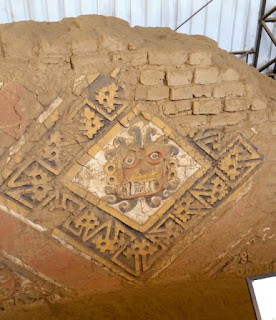Trujillo is a coastal city located in northwest Peru on
the banks of the Moche River and site of the great prehistoric Moche and
Chimú
cultures before the Inca conquest. Trujillo is in close proximity to two
major pre-Columbian archeological sites: Chan
Chan, the largest adobe city in the ancient
world and designated a World Heritage Site by UNESCO in 1986; and the Temples of the Sun and the Moon, the
largest adobe pyramid in Peru.
Our shore excursion today would include
a visit to both of these sites and was organized by Darla Bernard from New
York, who I connected with thru the Cruise Critics board. Darla located our guide at the end of the pier
and our group quickly formed, loaded onto our van and headed out for day of
adventure.
 |
| View of Temple of the Sun ruins from hike up to the Temple of the Moon |
Our first stop would be the Temple of the Moon. This site is located about 2.5 miles
from Trujillo. Strangly, we drove
right past Huaca del Sol, the Temple
of the Sun, without stopping. This
site was partially destroyed and looted by Spanish conquistadors in the 17th
century, while the Huaca de la Luna, Temple
of the Moon, was left relatively untouched. Archeologists believe that the Temple of the Sun may have been used for
administrative, military, and residential functions, as well as a burial mound
for the Moche elite. The Temple of the Moon served primarily for ceremonial and religious functions, though it contained burials as well.
 |
| Beginning of our hike up the hill to Temple of the Moon ruins |
Our stop was at the Temple of the Moon and as we walked past the entrance and began our ascent up the
long, steep dirt path to the ruins, I was struck by the total lack of color around me with the
exception of the soft brown of the adobe brickwork. At the time of construction, this site
would have been decorated in murals painted in black, bright red, sky blue,
white, and yellow, truly a site to behold for sure. Unfortunately, the sun and
weather have since faded the colorful murals.
Many of the later bricks used in the
structure bear one of more than 100 different markings believed to correspond
to different groups of laborers from different communities. Each group was assigned a mark to put on
their bricks, and these were then used to count the number of bricks laid for,
presumably financial and, I would guess, competitive purposes. I can envision a nightly conversation amongst
the men with the repetitive questions of “How many bricks did your team lay
today?” or “Tomorrow I bet our team can lay more bricks than your team.” Must be that male competitive thing.
 |
| Freedom Monument Fountain in Trujillo |
After leaving this site we headed to
downtown Trujillo. Very typical of most
cities in this part of the world, the Main Square revolves around the Freedom
Monument Fountain which commemorates their Proclamation of Independence of
1820. We took a brief 20 minutes here soaking in the
sights, sounds and smells of this bustling area and then headed off to our next
stop, the Chan Chan ruins.
 |
| One of the colorful building in downtown Trujillo |
Chan Chan is an archaeological site
located about 3 miles west of Trujillo and was the capital of the historical Chimú
culture. This fascinating civilization grew out of the remnants of the
Moche civilization. The adobe city of
Chan Chan was the largest in the world, built around 850 CE and lasting until
the Inca conquest in 1470. It was also
the imperial capital with over 30,000 inhabitants. The city has ten walled citadels which houses
ceremonial rooms, burial chambers, temples, reservoirs and residences. It is triangular in shape and surrounded by
50–60 foot high walls. The walls are
adobe brick covered with a smooth surface into which intricate designs are
carved.
Our group spent a
good hour here then made our way back to the ship for our 3:00pm sailing.







No comments:
Post a Comment